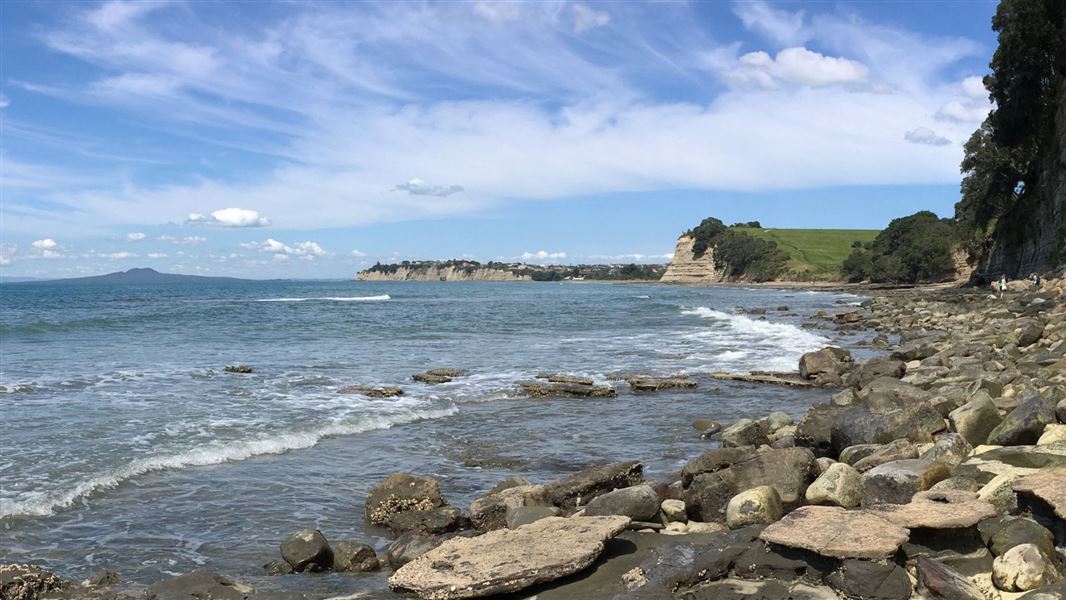The marine reserve was established in 1995 and is 980 hectares.
The reserve is about 20km from the Auckland CBD, and easily accessible by public transportation. Car parking and facilities are found at Long Bay Regional Park.
Swim/snorkel when conditions are safe
If you are not confident in the water, be realistic about your skills and swim only during calm weather or enjoy this place from land.
Check the surf forecast for Long Bay and pay close attention to the wind speed and swell height: Long Bay Surf Forecast. This is a surf forecast and the red/orange/green surfboard rating is not relevant to safe swimming, snorkelling or diving.
Dog access
Auckland Council manages the foreshore and parkland of the Long Bay Regional Park.
Long Bay Beach adjacent to Long Bay Regional Park
- Dogs are prohibited on the Northern Beach areas, north of Vaughan Stream at all times and not only during breeding season.
- Dogs are permitted throughout the year (with restrictions) on the Southern Beach Areas, south of Vaughan Stream.
- Full details of dog access rules at Long Bay Regional Park
Other beaches and marine reserve foreshore
To protect wildlife dogs are prohibited in the following areas:
- Okura Bush Walkway (including Stillwater section)
- Weiti Estuary Chenier Spits
- Crown foreshore of the Weiti River
- Karepiro Bay
- Okura Beach Marginal strip
Auckland Council's policy on dogs (PDF, 1,145K) – see page 14, section 6
Help us stop offenders
If you see people taking fish or other marine life within the marine reserve, report this to the DOC conservation emergency hotline 0800 DOC HOT (0800 362 468).
The Long Bay-Okura Marine Reserve was established in 1995. This was a community driven effort led by the East Coast Bays Coastal Protection Society.
The shores and waters of the Long Bay-Okura Marine Reserve are typical of those of the sheltered inner Hauraki Gulf. There is a diversity of coastal habitats that includes:
- the sandy beaches of Long Bay and Karepiro Bay
- the rocky reefs off the two headlands at either end of Long Bay
- the sandflats and mudflats of the Okura River and estuary.
While Toroa Point at the southern end of Long Bay is 'moderately exposed', the Okura River estuary, in contrast, becomes sheltered as it goes inland for some four kilometres, and its muddy waters host mangrove forests and saltmarsh.
Reporting pests
Find-A-Pest lets you report potential pest species, including marine, plant, animal and fungal species.
If you come across something out of the ordinary, upload a picture to the app and a specialist will help identify it. If it's a biosecurity threat, this will be forwarded to Biosecurity New Zealand. If possible, take photos and record the location and name of the vessel.
Or call the Ministry for Primary Industries' Pest and Diseases hotline on 0800 80 99 66.
Help stop the spread of exotic caulerpa
Keep an eye out for exotic caulerpa seaweed species and report suspected sightings to MPI. Ensure your boat and gear are free of any seaweed before moving locations.
Report illegal or suspicious activity
Don't take, disturb, kill or damage anything within the reserve - it's illegal. If you see people taking anything from the reserve, report the activity as soon as possible.
You can call 0800 4 POACHER (0800 476 224) or 0800 DOCHOT (0800 362 468).
It is also an offence to pollute or litter the reserve, discharge any firearm in or into the reserve or erect any structure in the reserve.
The marine reserve was established in 1995 and is 980 hectares.
Protect our marine reserves
- No fishing of any kind.
- Don't take or kill marine life.
- Don't remove or disturb any marine life or materials.
- Don't feed fish - it disturbs their natural behaviour.
- Take care when anchoring to avoid damaging the sea floor.
DOC Customer Service Centre
| Phone: | 0800 275 362 |
| Email: | aucklandnorthhead@doc.govt.nz |
| Address: | Maungauika / North Head Office |
